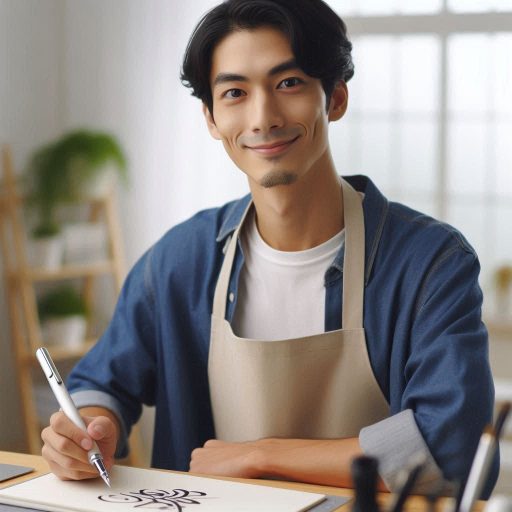Introduction
Art and design trends play a crucial role in shaping culture and industries.
These trends are constantly evolving, reflecting societal changes and technological advancements.
As we look ahead to the upcoming year, several key trends are set to make a significant impact.
Virtual and Augmented Reality Integration
One of the most exciting trends to watch is the integration of virtual and augmented reality in art and design.
This technology allows for immersive experiences, blurring the lines between physical and digital creations.
Sustainability and Eco-friendly Designs
Another trend gaining momentum is the focus on sustainability and eco-friendly designs.
Artists and designers are using recycled materials and incorporating nature-inspired elements into their work.
Minimalism and Simplistic Designs
Minimalism continues to be a strong trend, with its emphasis on clean lines and simplicity.
Designers are opting for uncluttered spaces and streamlined aesthetics in their creations.
Bold Colors and Abstract Shapes
On the other end of the spectrum, bold colors and abstract shapes are making a comeback.
Artists are experimenting with vibrant hues and unconventional geometries to create visually striking pieces.
Interactive and Kinetic Art
Interactive and kinetic art is also gaining popularity, engaging viewers through movement and participation.
These dynamic pieces challenge traditional notions of art and encourage audience interaction.
In essence, art and design trends are dynamic and ever-changing, reflecting the current cultural landscape.
By staying informed and embracing these trends, artists and designers can push the boundaries of creativity and innovation.
Sustainability and Eco-Friendly Design
One of the prominent trends to watch in art and design this year is the increasing focus on sustainability and eco-friendly design.
The world is becoming more conscious of the impact of human activities on the environment, and this awareness is reflected in the art and design industry.
Designers are now looking for ways to create beautiful pieces that are not only visually appealing but also environmentally friendly.
The increasing focus on sustainability in art and design
Designers are incorporating sustainable practices into their work, such as using recycled materials, reducing waste, and minimizing their carbon footprint.
This shift towards sustainability is driven by a desire to protect the planet and create a better future for generations to come.
Transform Your Career Today
Unlock a personalized career strategy that drives real results. Get tailored advice and a roadmap designed just for you.
Start NowExamples of eco-friendly materials and techniques being used
One example of eco-friendly materials being used in art and design is reclaimed wood.
Designers can create stunning furniture pieces using wood that has been salvaged from old buildings or furniture.
This not only reduces the demand for new wood but also gives new life to materials that would have otherwise been discarded.
Another popular eco-friendly technique is upcycling, which involves repurposing old or unused items into new, functional pieces of art.
This not only reduces waste but also adds a unique and creative touch to the design.
How consumers are driving this trend with their preferences for sustainable products
Consumers are becoming more aware of the environmental impact of their purchasing decisions and are actively seeking out sustainable products.
They are willing to pay a premium for items that are made ethically and sustainably, which is prompting designers to prioritize eco-friendly practices in their work.
Businesses recognize sustainability attracts customers.
They incorporate eco-friendly designs into branding.
Marketing strategies now emphasize green practices.
This approach appeals to environmentally conscious consumers.
This shift towards sustainability is not only good for the environment but also for business, as it appeals to a growing market of environmentally conscious consumers.
In fact, sustainability and eco-friendly design are key trends to watch in the art and design industry this year.
Designers embrace environmentally friendly practices.
They create beautiful, innovative pieces. These pieces captivate audiences.
They also contribute to a sustainable future.
Read: The Impact of Calligraphy on Modern Design
Minimalism and Simplicity
Minimalism and simplicity have been two design trends that have been gaining popularity in the art and product design world.
These trends focus on stripping away the unnecessary elements and embracing clean, simple lines and forms.
The rise of minimalistic and simplistic designs in art and product design
The rise of minimalistic and simplistic designs can be attributed to a shift towards a more mindful and clutter-free lifestyle.
Transform Your Career Today
Unlock a personalized career strategy that drives real results. Get tailored advice and a roadmap designed just for you.
Start NowPeople are increasingly seeking simplicity and minimalism in all aspects of their lives, including art and design.
Examples of artists and designers embracing this trend
Many artists and designers have embraced minimalism and simplicity in their work.
One prominent example is Japanese artist Yayoi Kusama, known for her minimalist approach to art and her use of repetitive patterns.
Another example is designer Dieter Rams, known for his minimalist design principles at Braun.
Impact of minimalism on consumer behaviors and preferences
The impact of minimalism on consumer behaviors and preferences has been profound.
Consumers are increasingly drawn to products and art that are simple, clean, and uncluttered.
Minimalistic designs convey a sense of sophistication and elegance, appealing to those who seek a more streamlined and minimalist lifestyle.
Abstract Art and Bold Colors
Abstract art and bold colors have made a major comeback in the world of design this year.
Artists and designers are embracing the freedom and creativity that comes with working in an abstract style, while also incorporating vibrant and eye-catching color palettes.
The resurgence of Abstract Art
Examining the resurgence of abstract art in design highlights the shift towards more unconventional and expressive forms of artistic expression.
Artists are using abstract forms to convey emotions, ideas, and concepts in a way that traditional art styles cannot.
Abstract art allows for a greater sense of experimentation and personal interpretation, making it a popular choice for artists looking to push boundaries.
Experimenting with Bold Colors and Shapes
Designers are not only embracing abstract art but also playing with bold colors and shapes to create visually stunning and impactful designs.
Bright and vivid hues are being used to evoke a range of emotions, from excitement and energy to tranquility and calmness.
Shapes and forms in design are becoming more dynamic and unconventional, adding a sense of movement and depth to compositions.
Emotional and Psychological Effects of Abstract Art
The emotional and psychological effects of abstract art on viewers are profound and varied, depending on individual interpretations and interactions with the artwork.
Abstract art can evoke feelings of joy, curiosity, confusion, or even contemplation, as viewers engage with the ambiguity and open-endedness of abstract forms.
Studies have shown that exposure to abstract art can stimulate creativity, enhance problem-solving skills, and encourage a more nuanced understanding of emotions and perceptions.
Read: How to Host a Calligraphy Workshop Successfully
Virtual Reality and Augmented Reality in Art
Overview of how technology is influencing art and design trends
Virtual reality (VR) and augmented reality (AR) transform the art world.
Transform Your Career Today
Unlock a personalized career strategy that drives real results. Get tailored advice and a roadmap designed just for you.
Start NowArtists gain new tools and techniques for creation.
They craft immersive, interactive experiences for audiences.
These technologies enhance artistic expression and audience engagement.
These technologies transform how artists create art.
They also change how audiences experience and share it.
Incorporating VR and AR into art and design has opened up a world of possibilities.
Artists can now create 3D sculptures, paintings, and installations that come to life when viewed through a VR headset or AR application.
This merging of physical and digital worlds has sparked a new wave of creativity and innovation in the art community.
Examples of artists incorporating virtual reality and augmented reality into their work
One example of an artist pushing the boundaries of VR and AR is Olafur Eliasson.
Eliasson creates large-scale installations with light and color.
He plays with space to engage viewers. His work embraces technology for immersive experiences.
These virtual environments transport viewers to otherworldly realms.
By combining traditional art mediums with cutting-edge technology, Eliasson blurs the lines between the real and the virtual, challenging our perceptions of art and reality.
Another artist at the forefront of incorporating VR and AR into her work is Marina Abramović.
Renowned for her performance art that pushes the limits of the body and mind, Abramović has embraced VR as a medium to explore new forms of expression and connection.
Abramović creates immersive experiences for her viewers.
She invites them to step into her world.
Through this, she pushes art’s boundaries. Her work transforms how we experience art.
Potential future of VR and AR in the art world
The potential future of VR and AR in the art world is vast and exciting.
As technology continues to evolve and become more accessible, artists will have even greater opportunities to create unique and engaging art experiences.
Transform Your Career Today
Unlock a personalized career strategy that drives real results. Get tailored advice and a roadmap designed just for you.
Start NowFrom interactive installations to virtual galleries, the possibilities are endless.
In the coming years, we can expect to see more artists experimenting with VR and AR, pushing the boundaries of what is possible in the art world.
These technologies have the potential to democratize art, making it more accessible to a wider audience and breaking down traditional barriers to entry.
As VR and AR become more integrated into our daily lives, we can anticipate a shift in how we interact with and consume art, opening up new avenues for creativity and expression.
Overall, the future of VR and AR in art is bright, offering artists new ways to connect with their audiences and explore innovative forms of expression.
As we continue to embrace technology in the art world, we can look forward to experiencing art in exciting and immersive ways that were previously unimaginable.
Read: Must-Read Books for Aspiring Calligraphers

Nostalgia and Retro Designs
Nostalgia has always been a powerful force in art and design, invoking emotions and memories from the past.
This year, we are seeing a resurgence of retro-inspired aesthetics in various creative fields.
The Allure of Retro Design Elements
From vintage typography to classic color palettes, retro design elements are making a comeback in a big way.
Consumers are drawn to these nostalgic touches that remind them of simpler times.
One popular retro design element that is making a strong resurgence is the use of neon lights.
Neon signs were iconic in the 80s and 90s, and now they are being incorporated into modern designs to add a touch of nostalgia.
Another retro design element that is gaining popularity is the use of bold patterns and textures reminiscent of the 70s and 80s.
These eye-catching elements add a sense of whimsy and playfulness to contemporary designs.
Why Consumers Are Drawn to Nostalgia in Art and Design
There are several reasons why consumers are increasingly drawn to nostalgia in art and design.
Nostalgia has a comforting and familiar quality that provides a sense of security and escapism from the present.
In a fast-paced and ever-changing world, nostalgia allows consumers to reconnect with their past and relive fond memories.
It offers authenticity and uniqueness. This stands out in today’s saturated market.
Additionally, nostalgia in art and design can evoke a sense of sentimentality and emotional connection.
Transform Your Career Today
Unlock a personalized career strategy that drives real results. Get tailored advice and a roadmap designed just for you.
Start NowBy tapping into familiar imagery and aesthetics from the past, designers can create a strong emotional resonance with their audience.
In general, the nostalgic trend in art and design, with a focus on retro-inspired aesthetics, is here to stay.
Nostalgia comforts and offers familiarity. It creates strong emotional connections.
Consumers seek these comforting feelings in their experiences.
As retro design elements continue to make a comeback, we can expect to see more innovative and creative uses of nostalgia in art and design.
Whether it’s through vintage typography, classic color palettes, or bold patterns, nostalgia will continue to influence and inspire creatives in the coming year.
Read: Understanding Typography in Calligraphy
Inclusivity and Diversity in Design
Importance of inclusivity and diversity in art and design
Exploring the importance of inclusivity and diversity in art and design is crucial in today’s society.
It is essential for artists and designers to reflect the diversity of the world around us in their work to create a more inclusive and representative industry.
- Embracing Different Perspectives: Artists and designers are recognizing the need to incorporate a variety of perspectives in their work to create a more inclusive and diverse range of art and design.
- Celebrating Cultural Diversity: Many artists are celebrating cultural diversity by incorporating elements from different cultures into their work, creating a more inclusive and globally-minded design aesthetic.
- Representation Matters: By showcasing a diverse range of voices and perspectives in art and design, the industry is evolving to become more representative of the world we live in.
Examples of artists and designers promoting inclusivity through their work
There are several artists and designers who have made inclusivity and diversity central themes in their work, pushing boundaries and challenging norms in the art and design world.
- Yinka Illori: A British-Nigerian designer known for his colorful and vibrant furniture designs that celebrate his dual cultural heritage.
- Tatyana Fazlalizadeh: An American artist who uses public art to address issues of race, gender, and street harassment, promoting inclusivity and social change.
- Mickalene Thomas: An American artist who creates bold, collage-style portraits of black women, challenging traditional notions of beauty and representation in art.
How the industry is evolving to be more representative of diverse voices and perspectives
The art and design industry embraces inclusivity and diversity.
It actively promotes artists from diverse backgrounds.
It encourages inclusive and representative practices in art.
- Collaboration and Networking: Artists and designers are collaborating across cultural boundaries to create cross-cultural art and design that reflects the diversity of our society.
- Education and Awareness: Art and design schools are incorporating diverse perspectives into their curriculum, educating students on the importance of inclusivity and diversity in their work.
- Industry Recognition: Award shows and exhibitions are increasingly recognizing and celebrating artists and designers who promote inclusivity and diversity through their work, shining a spotlight on diverse voices in the industry.
Handcrafted and Artisanal Goods
Overview of the growing appreciation for handcrafted and artisanal products
In today’s fast-paced and mass-produced world, there is a growing appreciation for handcrafted and artisanal goods.
Consumers are seeking products that are unique, authentically made, and showcase traditional craftsmanship.
This trend spans multiple industries. Fashion embraces it wholeheartedly.
Home decor showcases similar innovations. Food and beverage also reflect this change.
Handcrafted and artisanal products offer a sense of exclusivity and craftsmanship that mass-produced items cannot replicate.
Artisanal goods stand out in a crowded market.
They focus on attention to detail and quality materials.
Transform Your Career Today
Unlock a personalized career strategy that drives real results. Get tailored advice and a roadmap designed just for you.
Start NowEach item receives a personalized touch.
Consumers appreciate the uniqueness of these products. Generic products fail to offer the same experience.
People are increasingly interested in handcrafted items.
This trend counters fast fashion’s impersonal nature.
It also challenges disposable consumerism. Handcrafted products offer a personal touch and quality.
Consumers seek meaningful connections with their purchases.
Examples of traditional craftsmanship being celebrated in modern design
In modern design, traditional craftsmanship is being celebrated and integrated into contemporary aesthetics.
Artisans and craftsmen gain recognition for their skills.
Designers collaborate with them for unique creations. Brands join forces to produce limited-edition pieces.
Traditional artisans collaborate with modern designers.
They preserve age-old techniques together.
This partnership infuses innovation into classic crafts. The result showcases fresh, creative twists.
Analysis of the impact of artisanal goods on the mass market and consumer behaviors
The impact of artisanal goods on the mass market is notable, as more consumers are willing to invest in products that have a story behind them.
Artisanal goods appeal to those who value quality over quantity, sustainability over mass production, and individuality over conformity.
This shift in consumer behavior is challenging traditional retail models and pushing brands to rethink their approach to product development and marketing.
One of the reasons behind the popularity of artisanal goods is the desire for a more meaningful and personal connection with the products we purchase.
Knowing that an item was handcrafted by skilled artisans adds a sense of authenticity and value to the product.
Consumers are drawn to the craftsmanship, heritage, and cultural significance embedded in artisanal goods.
In a nutshell, the trend of handcrafted and artisanal goods represents a shift towards a more conscious and considered approach to consumption.
It is a celebration of craftsmanship, tradition, and human skill in a world dominated by mass production and fast fashion.
Transform Your Career Today
Unlock a personalized career strategy that drives real results. Get tailored advice and a roadmap designed just for you.
Start NowConsumers increasingly seek out artisanal products.
This demand drives a renaissance in traditional craftsmanship.
Modern design embraces these timeless skills and techniques.
As a result, craftsmanship flourishes in today’s market.
Shoppers value unique, handmade items more than ever.
Conclusion
It is evident that there are several key art and design trends to watch this year.
From sustainability and eco-friendly materials to bold colors and minimalism, the industry is constantly evolving.
As creatives, it is essential to stay informed and inspired by these trends to remain relevant and competitive.
We encourage readers to watch for industry trends.
Incorporate these trends into your work. Innovate to stand out effectively.
By staying ahead of the curve, artists and designers can push boundaries and create groundbreaking work that resonates with audiences.
Furthermore, we invite our readers to share their thoughts and predictions for the future of art and design trends.
Collaboration and dialogue are essential in fueling creativity and shaping the future of the industry.
Together, we can inspire and elevate the world of art and design.




